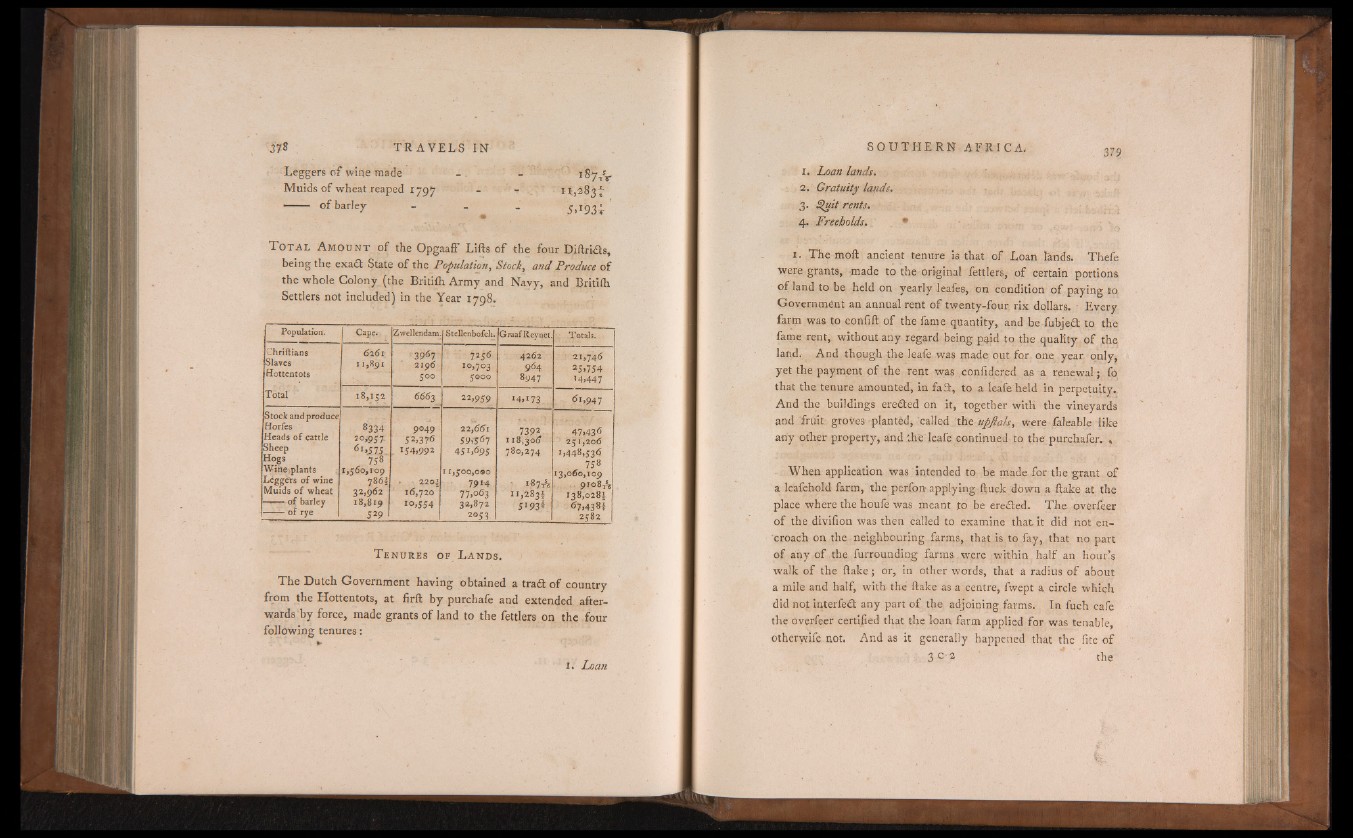
Leggers of wine made
Muids of wheat reaped 179*7 ~ ~
of barley - . . 5U93v '
W$m
T o t a l A m o u n t of the Opgaaff Lifts of the four Diftridts,
being the exadt State of the Population, Stock, and Produce of
the whole Colony (the BritiQi Army and Navy, and Britiih
Settlers not included) in the Year 1798.
Population. Cape. Zwellendam Stellenbofch. GraafReynet . Totals.
Chriftians
Slaves
Hottentots
Total
6261
1 1,891
3967
2196
500
72 56
10,703
5000
4262
964
8947
21,746
25*754
*4*447
18,152 6663 22,959 14. 17 3 61,947
Stock and produce
Horfes
Heads o f cattle
Sheep
Hogs
Wineqplants
Leggets o f wine
Muids o f wheat
—«— o f barley
— <-r— o f rye
8334
20,957.
6 i«575_
75*
1,560, rop
786I
32,962
18,819
529
9° 49
52.376
154,992
2201
16,720
IO*554
22,661
59,567
45'.695
1 1,500,090
791-4
77,063
32,872
2053
739?
118,306
780,274
1 8 7 A
” ,2831
5 * 9 3 !
47.436
5 251,206
1,448,536
. 758
13,060,109
91087*
138,028^
67,438!
2582
T e n u r e s o f L a n d s .
The Dutch Government having obtained a tradt of country
from the Hottentots, at firft by purchafe and extended afterwards
by force, made grants of land to the fettlers on the four
following tenures:
1. Loan lands.
2. Gratuity lands.
3. £$uit rents.
4. Freeholds. •
1. The moft ancient tenure is that of Loan lands. Thefe
were grants, made to the original fettlers, of certain portions
of land to be held on yearly Jeafes, on condition of paying to.
Government an annual rent of twenty-four rix dollars. Every
farm was to confift of the fame quantity, and be fubjed to the
fame rent, without any regard being paid to the quality of the
land. And though the leafe was made/out for one year only,
yet the payment of the rent was confidered as a renewal; fo
that the tenure amounted, in fait, to a leafe held in perpetuity.
And the buildings eredted on it, together with the vineyards
and fruit groves-planted» called the upjlals., were laleable like
any other property, and the leafe continued to the purchafer. ,
When application was intended to be made for the grant of
a leafehold farm, the perfon- applying ftuck down a ftake at the
place where the houfe was meant to be eredted. The overfeer
of the divifion was then called to examine that, it did not encroach
on the neighbouring farms, that is to fay, that no part
of any of the furrounding farms were within half an hour’s
walk of the ftake; or, in other words, that a radius of about
a mile and half, with the ftake as a centre, fwept a circle which
did not interfedt any part of the adjoining farms. In fuch cafe
the overfeer certified that the loan farm applied for was tenable,
otherwife not. And as it generally happened that the fite of
I 3C'2 j the